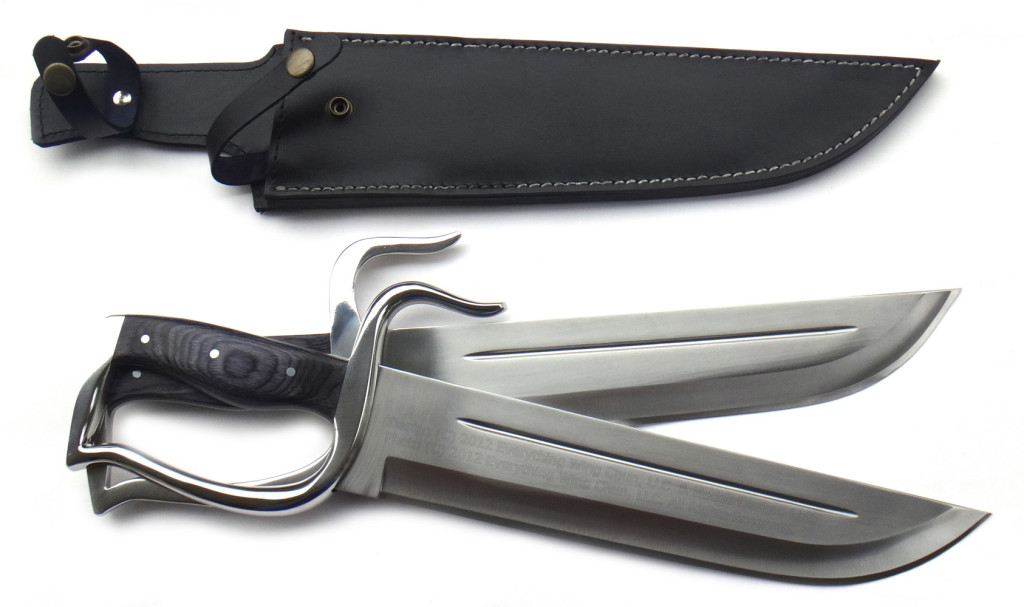We will now take a look at the sword blade length, and how it applies to your style. The correct blade length is determined by the style of martial art (Wing Chun, Hung Gar, etc), your lineage within that style (especially within Wing Chun), how you execute certain inside sweeping movements, if you flip the swords and block on the forearm, and your forearm length. Let's learn more about blade length.
The Sword Blade 2/2
Blade Length
Blade Length: Approx. length of actual blade from base to tip.
The correct blade length is determined based on style, lineage and body size. As a general rule you want the longest blade which allows you to safely perform all the techniques in your repertoire.
Between two equal matched opponents, a few extra inches of reach can easily be decisive. Bowie knife expert Bill Bagwell notes that in knife fighting, speed coupled with reach is lethal. The traditional Hudiedao blade designs and lengths take this into account. Most Kung Fu styles prefer a fairly long blade but Wing Chun uses additional techniques that limit safe blade length.
Wing Chun lineages typically require a length measured from the: (1) outside wrist to the outside the elbow (covering the entire forearm), known as “outside measure;” (2) tip of the biggest knuckle of a closed fist to the back of the outside elbow, which is the measure for Grandmaster William Cheung’s lineage, among others; (3) inside wrist to the inside of the elbow, known as “inside measure;” or (4) pocket of the thumb joint to the inside of the elbow, also known as inside measure. Wing Chun lineages can substitute a shorter blade, but the greater the differential from the correct length the less realistic the training.
Inside measure is necessary when the inventory of techniques includes flipping the knife inside the arm in the Guan Sao and Quan Sao movements. With longer blades the user would either cut their own arm or have to open their elbows too much, thus giving up valuable time and power generation in the movements. Historically each Wing Chun blade was custom fit for the practitioner, making both speed and power a non-issue.
An EWC survey of over 30 Sifus indicated inside measure lineages want a blade length of 12” or less. Twelve-inches is close to the longest traditional length for Wing Chun. This shorter version of a Hudiedao is rooted in the Red Boat days when the swords had to be concealed on the person, drawn rapidly without fault and used in close-quarter combat. A longer blade could be a disadvantage in many of these scenarios.
Custom knives are too expensive for most modern practitioners so the majority of students and Sifus make due with commercially available blade lengths. The 12” length blades are most commonly mass-produced, but there are also 11” models in a square D-Guard style discovered by Dr. John Lee in a Chinese tomb. This style BJD was adapted by the Leung Ting lineage and mass-produced in 11” and 13” lengths at the mid-grade quality level. In 2013 EWC began to offer its own luxury grade quality version “Tomb Warrior” BJD with several popular blade styles as limited editions.

Outside measure BJD do not accommodate many common Wing Chun techniques but offers greater reach. Longer swords also generate more rotational kinetic energy on slices and chops. Most Wing Chun lineages specify inside measure but before passing judgment on the balance struck by outside measure recall that the majority of martial arts styles prefer even longer Hudiedao blades.
Many chopper blade style lineages require a 13" blade based on historical precedent. Ip Man's bellied chopper knives were near this length. The Ip Man/Chun/Ching, Wong Shun Leung, Koo Sang and other popular lineages commonly use this length on their blades.
The standard production blade lengths for other Southern styles range from 14” to 15 ½.” Hung Gar lineages vary; either outside measure or a blade length a few inches past the elbow when the knives are held in a reverse grip. The appropriate blade length for a 6’ tall 180 pound modern Hung Gar stylist could easily run 16 ½”. San Soo prefers a blade length about 1” past the elbow in a reverse grip, or roughly 15” on the same size person, but the style permits practitioners to use the blade style and length they prefer. The blade length for Shaolin is to the end of the elbow when the knives are held in a reverse grip. A 14” to 14 ½” stabber blade is most appropriate for a practitioner in William Cheung’s Wing Chun line, but again the proper length is specific to the individual.
War Era Butterfly Swords had blade lengths that could easily run 18” to 24.” These dao are actually relatively longer since individuals were smaller then. There are a few surviving examples of War Era knives with more Wing Chun-like lengths, but the vast bulk of the swords from that time were for militia and other defense personnel rather than martial artists.
TIP: Your Sifu should be able to tell you the correct measure for your lineage.
Blade Length Guidelines:
10 inches: For lineages that measure from inside wrist to elbow.
Advantages: Allows for many Wing-Chun in-fighting close quarter sword techniques. Little danger of cutting own arms on in-fighting techniques and is easy to conceal.
Disadvantages: Does not cover to elbow on the outside of the forearm if flipped and limited reach.

12 inches: Generic Hybrid length for mass-produced swords.
Advantages: Not too bad for close combat, and still had some reach and heft. A good general choice for a school sword.
Disadvantages: Depending on the user's size and the use it could be too long or too short.

14 inches: Common for lineages that measure the blades along the outside of the forearm (wrist to elbow).
Advantages: Covers to the elbow or past the elbow when flipped. Extra length is good for stabbing and reaching an opponent.
Disadvantages: More difficult to wield in enclosed spaces. Cannot be used for some Wing Chun in-fighting techniques.

Longer: Some martial arts, like Hung Gar, require a blade that goes several inches past the elbow. This is uncommon in Wing Chun.

Ready for more? Click here to read everything you need to know about Blade Steel

I like the helpful information you provide on your articles. I will bookmark your blog and take a look at again here frequently. I’m quite certain I will learn a lot of new stuff proper here! Good luck for the next!
[url=http://frosports.benyalex.com/
nice article!